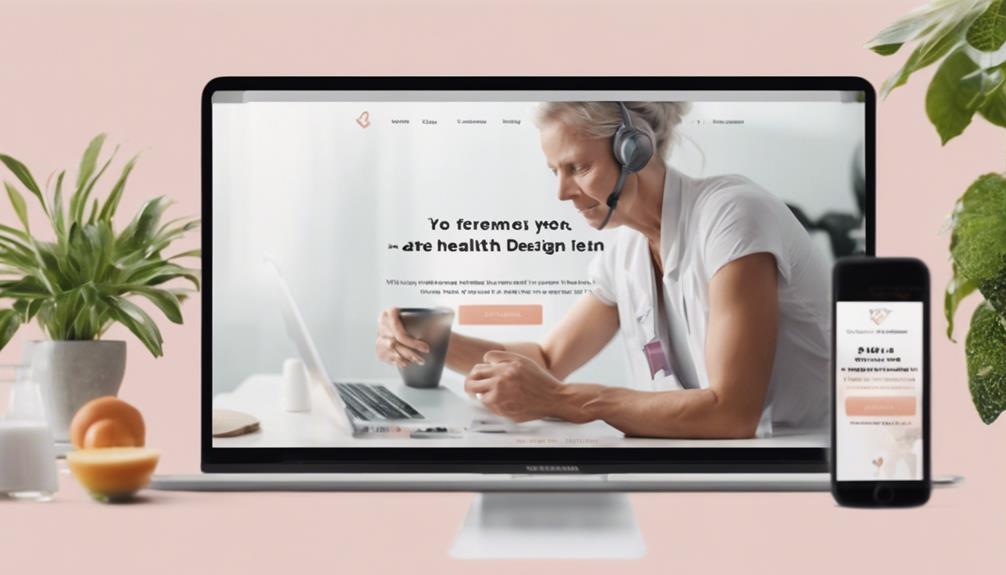In the realm of digital health, where user experience can significantly impact engagement and outcomes, staying abreast of web design trends is paramount.
The convergence of technology and wellness has birthed a landscape where aesthetics meet functionality to create seamless user journeys. From the rise of mobile-first design to the strategic use of minimalist layouts, each trend offers a piece of the puzzle in crafting websites that not only inform but also inspire action.
As we explore the seven health web design trends set to elevate user experience, a new era of digital health awaits, promising a blend of innovation and user-centricity that may reshape the way we interact with health information online.
Mobile-First Design

In modern web design practices, prioritizing mobile-first design has become essential for creating user-friendly and responsive websites. With the increasing use of smartphones and tablets, optimizing websites for mobile devices is crucial to provide a seamless user experience. Mobile web design focuses on designing websites for smaller screens first and then scaling up to larger screens, ensuring that content remains accessible and visually appealing across all devices.
Responsive web design techniques play a significant role in mobile-first design by allowing websites to adapt to different screen sizes and orientations. This approach not only enhances user experience but also boosts search engine rankings, as Google prioritizes mobile-friendly websites in its search results. By implementing mobile-first design principles, web designers can streamline navigation, improve loading times, and optimize content layout for a wide range of devices. Ultimately, prioritizing mobile web design leads to higher user engagement and satisfaction, making it a fundamental aspect of modern web development strategies.
Minimalist Layouts
Implementing minimalist layouts in web design enhances user focus and simplifies navigation, contributing to a clean and efficient user experience. In the realm of UI web design, minimalism emphasizes simplicity, clarity, and functionality. Modern web design trends often favor this approach due to its ability to streamline content and create visually appealing websites that are easy to use.
Minimalist layouts in web design prioritize essential elements, removing unnecessary clutter and distractions. This design philosophy promotes a user-centered approach by presenting information in a clear and organized manner. By incorporating ample white space, simple typography, and a limited color palette, minimalist layouts help users navigate the website with ease and focus on the most important content.
In the context of health web design, minimalist layouts can improve the overall user experience by reducing cognitive overload and enhancing readability. Users can quickly locate the information they need without being overwhelmed by excessive visuals or complex design elements. By embracing minimalist principles, designers can create sleek and intuitive interfaces that elevate the user experience to new heights.
High-Quality Visuals

With the rise of user engagement and visual storytelling in web design, incorporating high-quality visuals has become a pivotal aspect in creating captivating and immersive health websites. In the realm of web design trends, the use of high-quality visuals plays a significant role in enhancing user experience by making the content more engaging and appealing. High-quality visuals, such as crisp images, videos, infographics, and animations, not only attract the attention of visitors but also help in conveying information more effectively.
When it comes to health websites, the importance of using high-quality visuals is even more pronounced. Clear and visually appealing images of medical professionals, facilities, and procedures can instill trust and credibility in visitors. Additionally, interactive visuals like 3D models or virtual tours can provide users with a more immersive experience, helping them better understand complex medical concepts or services.
User-Centric Navigation
User engagement and seamless browsing experiences are paramount in health web design, thus emphasizing the significance of user-centric navigation. When it comes to web design for health-related platforms, user-centric navigation plays a crucial role in ensuring that visitors can easily access the information they need. Web design companies specializing in health websites prioritize intuitive navigation menus, clear call-to-action buttons, and logical information architecture to enhance user experience.
User-centric navigation involves creating a website layout that guides visitors through the content effortlessly, making it easy for them to find what they are looking for. By understanding user behavior and preferences, web designers can optimize navigation pathways to improve engagement and encourage users to explore further. Implementing features like breadcrumb trails, search bars, and well-organized menus can significantly enhance the overall usability of a health website.
Wellness-Focused Color Schemes

The selection of calming and soothing color palettes is pivotal in creating wellness-focused web designs for health-related platforms. When it comes to creative web design in the health industry, the choice of colors plays a significant role in evoking the right emotions and responses from users. Wellness-focused color schemes typically consist of soft, muted tones such as pastel blues, greens, and earthy neutrals. These colors are known for their ability to convey a sense of tranquility, serenity, and balance, which are essential in a health-related context.
Incorporating wellness-focused color schemes into web design can help create a visually appealing and harmonious user experience. By using colors that are associated with relaxation and well-being, health websites can establish a sense of trust and credibility with their audience. Additionally, these color palettes can contribute to reducing visual stress and creating a more inviting virtual environment for users seeking health-related information or services. When implemented thoughtfully, wellness-focused color schemes can enhance the overall user experience and contribute to the success of a health-focused website.
Interactive Features
Implementing dynamic interactive features elevates the user experience on health websites, fostering engagement and facilitating seamless navigation through valuable content. Interactive features such as quizzes, calculators, chatbots, and personalized tools not only make the website more engaging but also provide users with personalized experiences. These features can guide users in understanding complex health information, tracking their progress, and making informed decisions about their well-being.
In terms of user experience, interactive features play a crucial role in keeping visitors on the website for longer periods, reducing bounce rates, and encouraging return visits. By creating an interactive and user-friendly environment, web design can enhance the overall user experience and build trust with the audience. Additionally, interactive features can collect valuable data that can be used to further personalize the user experience and tailor content to individual needs.
Frequently Asked Questions
How Can Health Websites Effectively Incorporate Personalized Content to Cater to Individual User Needs?
To effectively incorporate personalized content on health websites, understanding individual user needs is paramount. Utilize data analytics to gather insights, create user personas, and tailor content to address specific health concerns. Engage users through interactive tools, personalized recommendations, and relevant information.
What Are Some Innovative Ways to Integrate Virtual Reality or Augmented Reality Technology Into Health Web Design?
Incorporating virtual reality and augmented reality technology into health web design can revolutionize user engagement by offering immersive experiences, interactive simulations, and personalized health education. These innovative tools can enhance user understanding and motivation for better health outcomes.
Are There Any Specific Considerations for Designing Health Websites for Users With Disabilities or Special Needs?
When designing health websites for users with disabilities or special needs, it is crucial to prioritize accessibility. Consider implementing features like alt text for images, keyboard navigation, and ensuring compatibility with screen readers to enhance user experience.
How Can Health Websites Ensure Data Security and Privacy Protection for Users Interacting With the Platform?
Ensuring data security and privacy protection on health websites involves robust encryption protocols, secure data storage, regular security audits, compliance with industry regulations like HIPAA, user authentication measures, and educating staff on data protection best practices.
What Are Some Emerging Trends in Health Web Design That Are Not yet Widely Adopted but Show Potential for Enhancing User Experience in the Future?
As the digital landscape evolves, emerging trends in web design hold promise for enhancing user experiences. By incorporating innovative features and interactive elements, websites can create more engaging and personalized interactions, ultimately improving user satisfaction and loyalty.

